
If I ever start a band, that could be our name. And we’ll climb over every obstacle to reach the top, ’cause that’s what P-berry does. But of course we couldn’t do it without the Edge, and the legions of unwitting fans who enable our success. If any of this makes sense to you, then you already know Porcelainberry, Ampelopsis brevipedunculata – that urban scourge of a grapevine with the crazy colored berries.
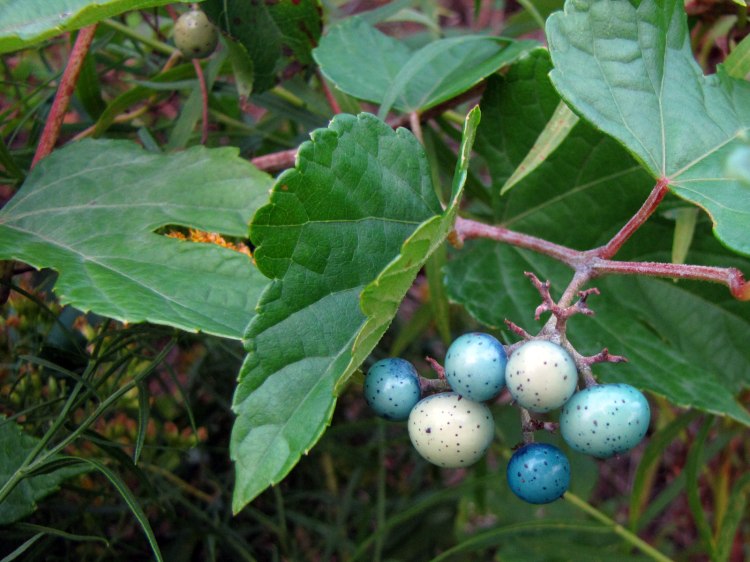
Forty years ago, an aspiring young botanical artist walked by a chain link fence, and a vine with lovely blue berries caught her eye. She was so enchanted by this unusual new plant, she brought some home to illustrate. I probably still have that illustration in a box somewhere, documenting the first encounter in what has become a difficult relationship.
In those days P-berry was relatively uncommon in this area, but now it’s ubiquitous. An unusually fast trajectory even for an invasive plant – but P-berry’s had plenty of help. And once again we whine about it, but don’t see how we set the stage for it’s rise (literally). And that’s where the edge comes in…
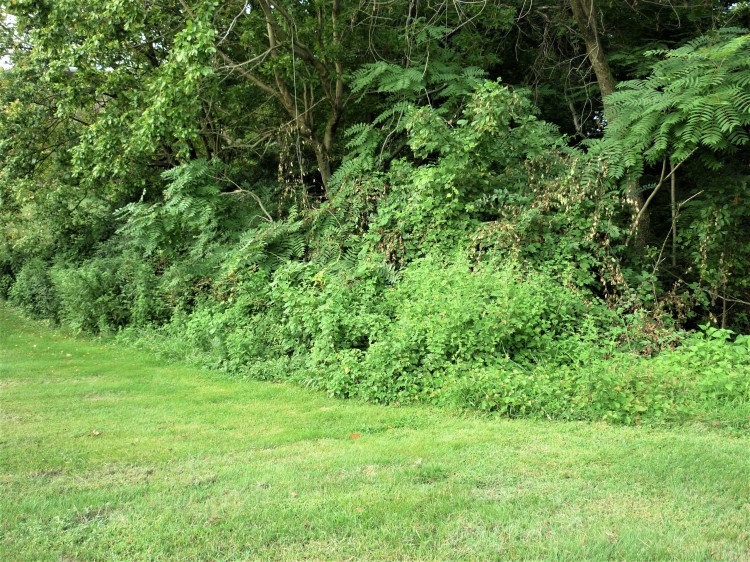
This kind of neatly mowed edge can be seen everywhere, marking the line between human management and the mostly “wild” (uninviting to people) landscape beyond it. Before mowing, the edge did not exist. That’s right – our ability to easily create and maintain a sharp boundary between two very different habitats is relatively new. As a plant person, I’ve always been fascinated by this interface since there’s a lot going on, botanically speaking. Vines in particular love the edge since there’s loads of sunlight and no competition on the mowed side, and handy shrubs and overhanging branches to climb just beyond it. Frugivorous birds like robins hang out there, eating some berries, excreting others. Honestly, we couldn’t have created a better place for Porcelainberry to thrive if we’d tried.
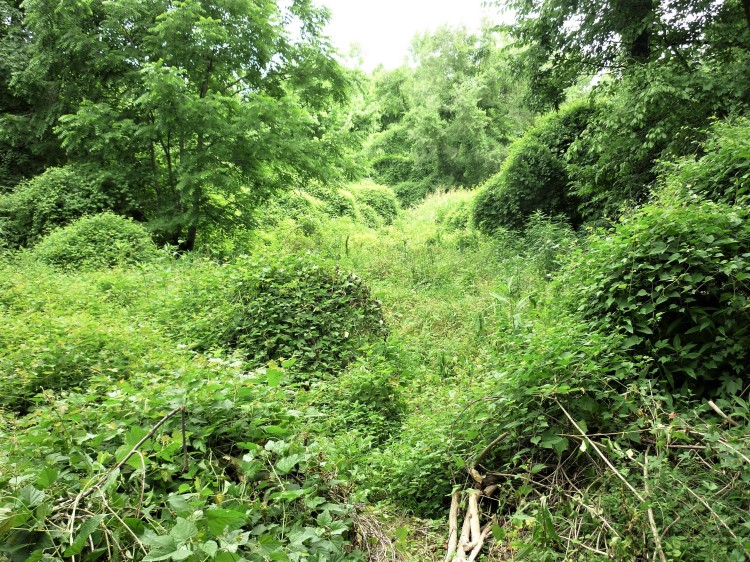
This mini-kudzu-like vine (also known as Amur Pepper-vine) doesn’t just stay on the edge, but rolls over it if possible, pulling down anything in its path. Young trees don’t stand a chance, so succession in meadows or gaps is effectively stalled out and replaced by a relative monoculture. A Box elder sapling in the grip of P-berry (pic below) may survive, but will be so bent that’s it’s best to cut it off and let it regrow.
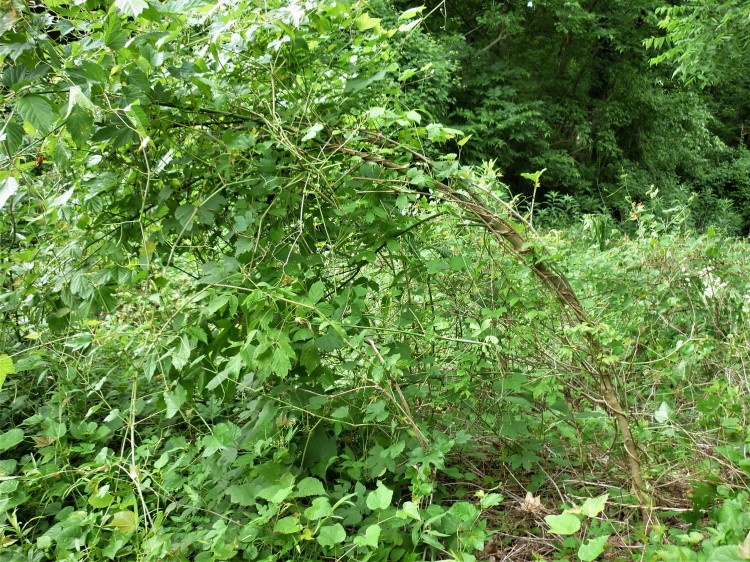
Older trees, such as the Black walnut below, are not immune to the damage. The weight load of vines pulls them down over time, causing a multitude of lateral branches and no upward trajectory. In the image, you can see how the forest stewards have cut the vines “high and low” – near the ground and as high as we could reach – to break the climbing ladder that enables P-berry (and other vines) to ascend to the light. This climbing habit is also typical of native grapevines, genus Vitis, which clamber up trees on the edge and inside forests. But their growth rate is slower and they lack the ability to envelope sunny sites in a blanket of dense foliage.
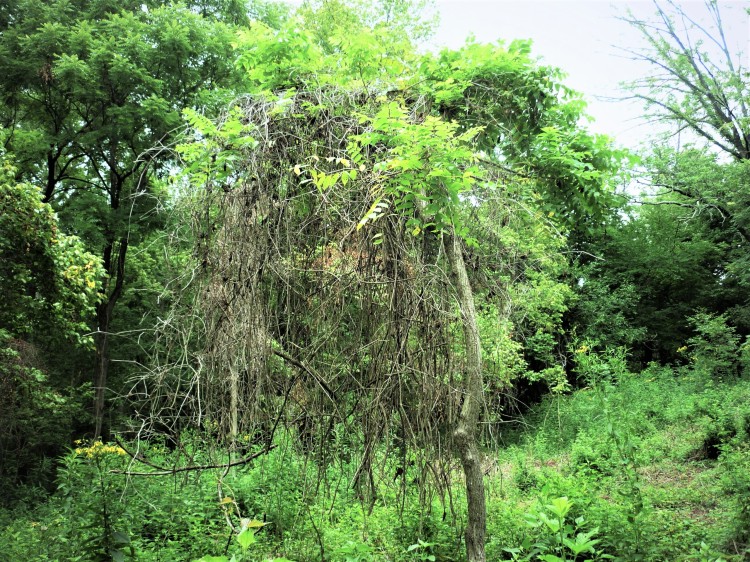
Cutting the vines back is just the first step in a tiresome process that includes treating with herbicides in two different ways. (In fact it was this plant that convinced me to get an applicator’s license.) In the remainder of this post, I will share a bit of the multi-year process we’ve undertaken to bring a few sites back to a more normal successional state.
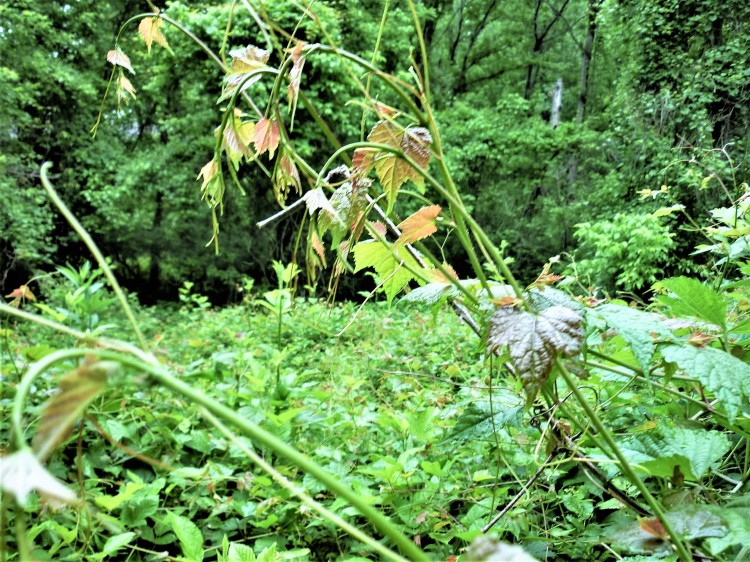
Several large gaps on the edge of the forest (yes, the place where the mowing ends) had become deeply infested with this plant, to the point where its snakelike roots crisscrossed the clearings like piles of rope. This network of partially above-ground storage roots is what enables Porcelainberry to survive endless amounts of cutting back. It just regrows again and again, with seemingly unassailable vigor. The clearings had been overwhelmed to the point where few plants besides blackberry could raise themselves above the sprawling mass. Spraying with herbicide would likely kill everything, so we waited until the dormant season and went after those massive roots.

The above ground sprawling root system anchors itself into the soil with smaller penetrating roots every foot or so, and also sends up aerial shoots at these “nodes”. It’s a unique adaptation, and surely helps Porcelainberry survive in the type of environment where it evolved. When you see this sort of uber-survival trait in a plant, it’s a good guess the niche where it evolved is very competitive!
The first herbicide treatment we used on the roots was the “cut-stump treatment” – dripping a high concentration of glyphosate onto the cut end and several more cuts below it. Although this will finish off a certain percentage of roots, their very length makes them pretty hardy. When the area leafs out in spring, the vines that regrow are foliar sprayed, often for several seasons. This is where it gets tedious – scouting through a densely grown recovering meadow week after week for the ones that got away.


But I’m happy to report that with persistence it can be done. The before and after pics above, are of the site we most recently worked on. What is notable is the number of plant species that have moved in recently, as well as the recovery of those already on the site. Supplemental seed dispersal of Ironweed, Joe pye weed, Mountain mint and Virginia wild rye has helped a lot. And we planted trees – Cottonwood, Tulip tree, Black willow, Pin oak, Swamp white oak, Sweetgum, Sycamore.
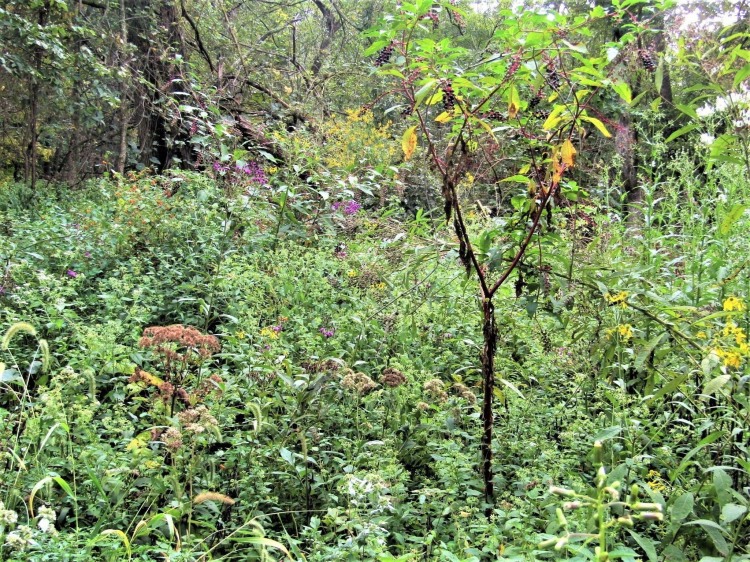
Because as lovely as this meadow looks right now, the gap needs to close. Why, you might ask? Left to its own succession, minus Porcelainberry and deer pressure, it would soon grow up to trees anyway, since that’s what happens to forest gaps in the eastern US. Tree planting is speeding things up a bit, to help prevent P-berry re-infestation. Different from the other invasive plants we deal with, Porcelainberry seedling growth rate is definitely inhibited by shade – that’s why it has to find something to climb.
In my research for this post, I learned that P-berry has several native relatives in the US – Heartleaf peppervine, Ampelopsis cordata being the most likely to occur in the same regions infested by P-berry. And this is where the plot thickens. Since the invasive plant Porcelainberry is native to China, Korea, and Japan, that means the genus Ampelopsis is disjunct, or found naturally in two widely separated parts of the world. I call this our “Asia connection”, because much of the flora of eastern North America is indeed most closely related to that of Asia. (The reason why is a fascinating story, and I delve into it in my post from 8/29/17 “The Global Forest”.
Genetic analysis is now showing that the genus Ampelopsis likely originated in North America during the Miocene period and only later made its way to Asia, and to South America. So in a sense, this is just a homecoming for the particular species of Ampelopsis known as Porcelainberry – returning as a much strengthened competitor to a landscape with the door wide open to welcome it.


Array
This really is fascinating. Our peppervine (Ampelopsis arborea) is native to Texas, and it’s not nearly so — enthusiastic — in its growth patterns. It will wander, and climb, but it certainly is more well-behaved than other invasives, like Japanese honeysuckle and salt cedar. The thought that this genus started here, traveled, and returned, is just remarkable.
I will say those berries are beautiful. It’s interesting, too, that the speckled appearance resembles ripening peppervine berries. They turn pink rather than blue, but they have those same speckles.
LikeLiked by 1 person
oneforestfragment
I am fascinated by the evolution and movements of plants, and their relationships. The connection between the flora of China and Japan, and the Eastern US is particularly interesting, and helps explain the invasive plant, insect, and disease issues in this region.
LikeLiked by 1 person
tonytomeo
This is one that is pretty in pictures, but maybe not in our own landscapes. I would like it in town, but would not want it to escape into the forest here. Even in town, I would be concerned about where the seed could end up.
LikeLiked by 1 person
oneforestfragment
This plant’s bird-dispersed berries literally end up everywhere in our urban area, I see the seedlings in lawns, on roadsides, in the woods, you name it. It’s quite amazing coverage they achieve.
LikeLiked by 1 person
tonytomeo
That is how invasive exotic species get started.
LikeLiked by 1 person
oneforestfragment
Birds excrete with amazing frequency, anywhere and everywhere. I live with eight birds in my home, six of which are free range part of the day, so I’ve learned this first-hand.
LikeLiked by 1 person